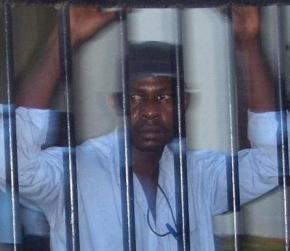Immigrants resist in the Dominican Republic
reports on efforts by activists in the Dominican Republic to build support for Haitian immigrants.
THE IMMIGRANT rights struggle in the Dominican Republic is back in the mainstream political debate after a 24-hour church occupation January 5 in Dajabón province by some 600 Haitian immigrants that took the government by surprise.
The church occupation came at a time when labor strikes and student demonstrations are spreading nationwide as the economic crisis deepens.
The immigrant workers' action was led by Father Regino Martínez, a Jesuit priest. Martínez is the coordinator of Border Solidarity (SF, by its initials in Spanish), a local non-governmental organization that works with both Haitian immigrants and Dominican peasants throughout the border regions.
Many of the immigrants who occupied the church work in the agricultural sector and have lived in the Dominican Republic for a number of years. In the 1980s, unionized workers occupied churches to bring attention to their struggles--but this is the first time that the immigrant rights movement has adopted this tactic. Women, men and children took part in the unprecedented action.

The action came in response to actions by the Border Security Specialized Corps (CESFRONT), which refused to allow hundreds of Haitian immigrants to return to the country after having spent Christmas holidays in neighboring Haiti. But immigrants and their supporters defied authorities by seeking refuge inside the church. SF organizers said that the occupation was justified because immigrants only wanted to return to their jobs and homes. Remaining in Haiti is not an option for them: the country is facing a humanitarian catastrophe after four hurricanes struck the country last year. Meanwhile, a UN military occupation continues to inflict a brutal repression against ordinary people.
To ensure that these immigrant workers are allowed to return to the Dominican Republic, SF conducts cross-border caravans to Haiti during the holidays. This year, however, the journey to Haiti became a point of friction between SF and CESFRONT, which threatened immigrants with arrest and deportation.
Thus on January 4, SF helped some 600 Haitian immigrants make their way back to the Dominican Republic on the eve of the weekly bi-national market, one of the biggest open markets in the Caribbean. But thousands of undocumented Haitian immigrants who traveled to Haiti for the holidays weren't able to do so. Those who did manage to return took action by occupying the church.
The government moved quickly to end the occupation by dispatching heavily armed soldiers to surround the church. They allowed no food, water or medical services for those inside. Eventually, government officials met with SF's Martínez, who agreed to leave the church to prevent a military assault that could have resulted in a bloodbath.
Although the occupation ended peacefully, it didn't accomplish its original goal. According to the EFE news agency, only 80 people were allowed to stay in the Dominican Republic because they had temporary work permits. The media even has accused Martínez of charging immigrants money in order to cross the border.
Furthermore, the government and anti-immigration politicians threatened to prosecute Martínez for bringing "illegal immigrants" into the country, but later backed down. Even so, Martínez has continued to call for an amnesty for Haitian immigrants who have lived in the country for more than five years.
THE CHURCH occupation was the latest in a series of challenges to the government's anti-immigrant policies. Since 2007, human right violations have become more acute after CESFRONT's arrival on the Dominican-Haitian border. For example, the local economy in Dajabón is dependent on the influx of goods and people from Ouanaminthe, a Haitian city right across the border. Thus the anti-immigrant crackdown affects Dominicans as wells as people of Haitian origin.
In response, a coalition of Dominican and Haitian organizations allied with local politicians and businesses forced the government to remove CESFRONT from the region as life became unbearable for ordinary people from both sides of the island. Their efforts led to the transfer of the original military contingent and its replacement by a new one.
But CESFRONT continues to brutalize immigrants at the border. On January 12, a Haitian man died after being shot by military border police. Moreover, soldiers from the United Nations Stabilization Mission in Haiti (MINUSTAH, by its French initials) have in the past repressed pro-immigrant protests on the Haitian side of the border.
Haitian immigrants live in fear as the Dominican government conducts raids and deportations. Many Haitian workers also live in segregated communities under the watch of armed security guards as a way to prevent them from organizing in unions, such as the Haitian and Black Dominican construction workers in the eastern town of Bávaro.
As always, the Dominican government is using Haitians as scapegoats for the economic crisis. Since October, racist attacks against Haitian immigrants have increased, leading to the death of several immigrants, while countless others have been wounded. However, those implicated are rarely brought to justice.
But anti-immigrant violence has not deterred immigrants from fighting back. Last year, 120 Haitian immigrants on their way to Haiti mutinied on a bus as they were being deported. More recently, seven Haitian construction workers were arrested after they blocked a street to demand payment for their labor.
As mass layoffs hit both Haitian and Dominican workers, more combative protests will take place. Their unity is crucial to win better working conditions and wages for all, as well as basic civil rights for undocumented Haitian immigrants.


